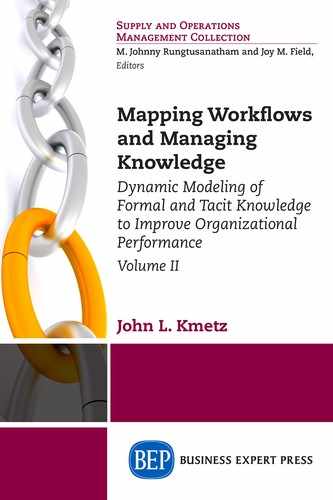This is the second of two volumes in this series. In Volume I, we learned the Kmetz method of Workflow Mapping and Analysis (WFMA), which uses a set of five symbols under disciplined conditions to describe virtually any workflow process through an organization. In addition, this method is able to capture the tacit knowledge in these workflows and illustrate the relationships of that knowledge to the outcomes of the process as well as the effects. These workflow maps are actually static models of the processes, and provide a basis for process improvement in addition to valid descriptions of processes.
The Kmetz method of WFMA provides three fundamental capabilities:
It is a thinking tool. It requires the mapper to think through the process and, at the same time, provides a consistent method to capture that thinking.
It is a communication tool. It allows description of any system, simple or complex, to any audience using a very robust and consistent graphical portrayal of the process.
It is an analytical tool. It provides a basis for testing the accuracy of information about processes, and for exploring changes to those processes before they are implemented.
While the method has the distinct advantage of being simple and easy to learn, it has its limitations. One of these is inherent to any static model, and that is that it cannot be manipulated to investigate different options in the design of a workflow or the impact of systemic changes on it. Dynamic simulation enables such manipulations, allowing users to experiment with many forms of change before implementing any of them. It also takes a different view of the company or organization, in that the scale of the investigation can be varied to yield insights into the functioning of the larger system; we can exclude minute details of day-to-day operations while focusing on key variables that influence outcomes, and can view the organization as an entity from afar as we observe other variables as well. As we learn the functioning and properties of the system, we can add detail into our model as needed or desired.
Much of the spirit of dynamic modeling can be traced to the work of Jay W. Forrester at the Massachusetts Institute of Technology. Forrester worked at the level of the macro-researcher, developing both the concepts and tools needed to investigate a variety of complex systems. Many others have shown the value of his work by applying them to more mundane but challenging phenomena, such as magazine publishing and curling clubs. What all of these people have shown is that we can use models to test our own understanding of these systems, and learn from that.
Chapter 1 of this volume provides the reader with my reasons for proposing that system dynamic (SD) modeling is a valuable management tool. My early experiences with such modeling, both from a user perspective as well as a contributor to the construction of these models, convinced me that such tools can offer insights and explain outcomes that are otherwise invisible through observation of the day-to-day processes of the organization. Chapter 2 is an introduction to iThink, a specific program for SD modeling, and one that I recommend for its flexibility in modeling many kinds of variables we encounter in organizations, including “soft-system” variables such as motivation, trust, commitment, and the like. While not at all comprehensive of the potential of iThink, enough familiarity with it is provided to allow an interested reader to follow some models. Finally, Chapter 3 looks into some of the broader questions that surround such modeling, including its linkages to the tacit knowledge that first motivated the Kmetz method of workflow analysis. I also go into the requirements for transitioning from static WFMA models to SD models, and provide some external links that can be helpful in learning SD modeling.
Modeling of any kind is a learning tool first, and a prediction tool last. It is in this spirit that I prepared this short volume, and I hope it will encourage both learning and application of system dynamic modeling.
